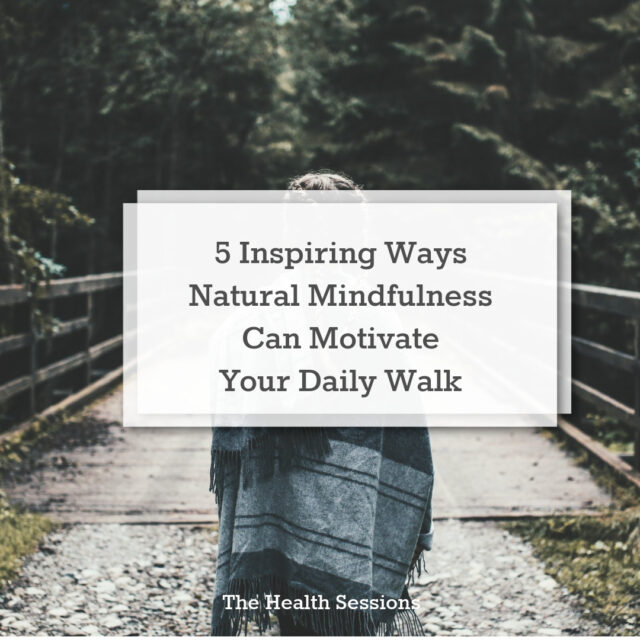How to Deal with Sensory Overload: 19 Coping Strategies

This article is written by Jemma Louise Hunt from A Wellness Tale.
Many of us turn to walking as an introduction to exercise following months and years of being housebound by chronic illness. And in the early days, the first tentative steps towards movement are enough to keep us fully motivated and inspired. There is triumph in circuiting the garden for the first time, and pride in ambling up to a neighbour’s house and back, because nothing beats the euphoria of smashing your earlier walking goals.
But healing in chronic illness is never linear and there are often setbacks. Maybe through enthusiasm or sheer determination you walked beyond your current exertion limits, weakening your body and its capabilities? Or perhaps you have reached the peak of your current abilities and a long, frustrating plateau ensues?
It is at this point we might begin to lose motivation, and if the exhilarating and celebratory moments of our early achievements no longer encourage us, what can we look to for inspiration going forward?
Natural Mindfulness
Natural Mindfulness is an enchanting mindful practice that is based in nature. Through its varying exercises we’re encouraged to come home to the present, open our senses and heart space and explore a deeper connection with the natural world. As our senses heighten and the love in our heart soars ,we begin to tap into the healing vibrational energy of the land that surrounds us, to tune into its heartbeat.
Have you ever stood beneath a majestic tree and felt a sense of awe and wonder, or looked at an incredible view and felt a wave of clarity, knowing that you could tackle whatever problem lay ahead? That is nature’s replenishing and invigorating energy radiating from within you, and it is through this energy we can empower ourselves to walk onwards when we’re losing momentum.
Here are 5 ways in which Natural Mindfulness can rejuvenate your daily walks, enhance your mindset and guide you towards a more mindful walking experience.

Most of us use our daily walk as a time to ponder over life’s problems. The health issue that won’t go away, an argument we had with a friend or the pile of unopened bills on the desk back home. But walks in nature should be a time of refuge from our day to day stresses and so clearing our mind of all thought is very important.
It can be hard to quieten the mind in the beginning and one way to lessen superfluous chatter is to replace those thoughts with something powerful and uplifting. Much has already been written about gratitude lists and using affirmations to bring about a more positive mindset, but did you know that you can bring this practice to your daily walks?
Start by listing three things that you feel grateful for. It could be something as simple as the woolly hat on your head that is keeping you warm, maybe it is a beautiful sunny day or a stranger greeted you kindly?
If you find gratitude difficult to practise, you might prefer to set wishes or intentions. Create statements that inspire you to show up for your walk when motivation is low. You might want to affirm that your leg muscles are growing stronger with every step, or that you are striding towards a healthier you.
It doesn’t matter what you whisper to yourself, just as long as it is leading you away from mindless thinking and towards an open, loving and receptive mindset that is ready to embrace Natural Mindfulness.
Walking mindfully is different to that of fitness walking. The latter is a workout. It concentrates on speed and acceleration of the heart rate. The end goal is to push your limits, which is well documented as being detrimental in chronic illness.
Mindful walking has a different end goal. It is gentle, calming and aims towards inner peace, so a slower pace is preferred. Learning to slow down and embrace a plodding stride can be really beneficial to your healing. At a leisurely pace you experience less post-exertional malaise because you’re walking within your body’s means. Less post-exertional malaise means less stress on the body, allowing it the opportunity to heal, build up stamina and over time, even the ability to lengthen daily walks.
Having a chronic condition means it is likely that you need to take a rest mid-walk, and this is the perfect chance to practise a powerful Natural Mindfulness exercise.
Find yourself a quiet sit-spot. It might be your favourite swing in the local park, the rickety old bench that you pass along your chosen footpath or an old tree stump in the middle of an open field. Once seated, close your eyes and breathe deeply, releasing all your stress and tension on the exhale. Now bring your awareness to the natural noises around you. Concentrate on the louder, more obvious sounds such as the chatter of people, a chorus of bird song or the wind whistling past your ears.
List three things and then go deeper into the practice by paying attention to the more subtle sounds. Are the hedges rustling in the breeze, perhaps a gate is creaking on its hinges or rain drips from a nearby lamppost? Take time to really hone your listening skills and with time you’ll discern sounds you never even knew were there.
Continuing this mindful moment from your sit-spot, open your eyes and really see what is before you. Note the different colours, the vibrancy and textures of the current season. Picture the delicate, pastel shades of spring or the deep, luscious palette of summer. Observe the rustic tones of autumn and the nakedness of winter. Every season is a visual delight, if we take the time to observe it properly.
Taking this visual exploration further, examine the natural layout before you. Follow the curve of the land and the natural formations of the countryside, or study the shapes and shadows of the high-rise buildings that tower over city parks. Returning to your gratitude, practise beginning to feel into these surroundings, appreciate and truly love them. And if you’re lucky, you might start to feel nature’s love in return.
By now you will begin to feel a deeper connection with nature, that you are a part of it. You might feel the fluttering sensation of excitement in your heart or belly. Perhaps you feel brighter and alert? Take these sensations with you as you continue plodding into this final exercise where you’re invited to really engage and have fun with the natural world, which is the essence of Natural Mindfulness.
Let down your hood when it’s raining, feel the weather against your skin. Squelch your feet through the muddy puddles along sodden footpaths, and kick your feet through the fallen leaves. Reach for the flowers and foliage, breathe in their scent and uncover the different textures. This is an invitation to be inquisitive, so go ahead and explore. Take photographs, collect keepsakes and gather mud beneath your fingernails. Rediscover nature with childlike wonderment.

Whatever stage you’re at on your chronic illness journey, a slow walk in the fresh air combined with Natural Mindfulness will be very beneficial. As your body regulates its serotonin levels and releases endorphins, you will experience marked improvements in your mood and mindset, helping you to view your health limitations through fresh eyes.
Over time, whether you walk independently or with the use of aids, you might even find that you slump less and no longer drag your feet as your core and muscles get stronger. Be mindful that there is no right and wrong in Natural Mindfulness, every experience is unique to you and your situation.
So take your time and explore the exercises one by one. No matter how short your walks, let’s make them extraordinary!
For more inspiration on how to access the healing magic of nature, check out A Wellness Tales mindful posts on Instagram.
If you enjoyed reading this post, you might also like: